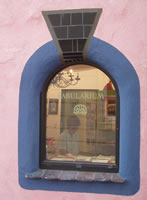Hundertwasser is and was a great inspiration, not only for the art and architectural world but even more so for humanity ...
He was born with the name Friedrich Stowasser, on the 15 December 1928 in Vienna, Austria..
and he past over on the 19. of February 2000.
He may have been called controversial, which I see as meaningless, any artist, with a creative output and compassion and standing for nature and human rights would be called controversial. Actually I think it should be the other way around.
It is interesting to note how some people write about him. By example, you may read about his art; >> "unruly, shocking artistic vision or the rejection of the straight line.
However as an artist, there is nothing unruly or shocking,
and instead of saying; rejection of the straight line, one can as well say;
" A Love for Organic forms ", and that is actually what it comes down to, a love of nature and the organic form, with bright colours, as a reconciliation of humans with nature, and to express this, one needs strong individualism, compassion and conviction..
Hundertwasser was firstly inspired by nature, and further more by artists such as Egon Schiele from an early date, and his style was often compared to that of Gustav Klimt.
He was fascinated with spirals, and called straight lines "the devil's tools".
He called his theory of art "transautomatism", based on Surrealism, but focusing on the experience of the viewer, rather than the artist, which simply put means;
Different people see different things in the same picture.
He changed his name from Stowasser to Hundertwasser, meaning "onehundred waters".
Sto is a Czech word for one hundred - and wasser is a German word for water ..
His first name Friedrich became Friedensreich - meaning a "Kingdom of Peace"
His other names, Regentag and Dunkelbunt, translate to "Rainy day" and "Darkly multicoloured".
Although Hundertwasser first achieved notoriety for his boldly-coloured paintings, he is more widely renowned today for his revolutionary architectural designs, which incorporate natural features of the landscape, and use of irregular forms in his building design.
HIs last work featured on this web-site is a good example -
see The GREEN CITADEL OF MAGDEBURG
Hundertwasser felt that standard architecture could not be called art, and declared that the design of any building should be influenced by the aesthetics of its eventual tenants.
He wrote a number of "manifestos", his first one on the 4. of July 1958, the so-called Mould Manifesto against rationalism in architecture, in the abbey of Seckau.

"A person in a rented apartment must be able to lean out of his window and scrape off the masonry within arm's reach. And he must be allowed to take a long brush and paint everything outside within arm's reach. So that it will be visible from afar to everyone in the street that someone lives there who is different from the imprisoned, enslaved, standardised man who lives next door."
His work has been used for flags, stamps, coins, posters, schools, churches, a public toilet in Kawakawa in his adopted home of New Zealand, and apartment buildings.
He has also designed stamps for the United Nations post administration in Geneva on the occasion of the 35th anniversary of the Universal Declaration of Human Rights.
In 1999 he started his last project named Die Grüne Zitadelle von Magdeburg. Although he died before it was completed a few years later in Magdeburg, a town in Germany on October 3, 2005.
Hundertwasser was buried after his death at sea on the RMS Queen Elizabeth 2 in 2000.

